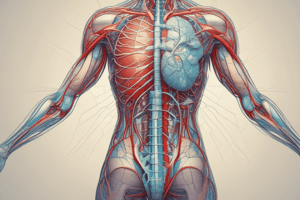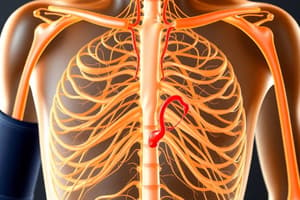Podcast
Questions and Answers
What factor determines the continuous blood flow in the capillaries?
What factor determines the continuous blood flow in the capillaries?
- Elasticity of the aorta and arteries (correct)
- Red blood cell count
- Presence of valves in the veins
- Large mass of circulating blood
What is the volume of blood flowing through the cross-section of a vessel per unit time directly proportional to?
What is the volume of blood flowing through the cross-section of a vessel per unit time directly proportional to?
- Pressure differences at the beginning and end of the vessel (correct)
- Blood pressure at the end of the vessel
- Force of heart contraction
- Viscosity of blood in the vessel
Which of the following changes in functional parameters is involved in arteriolar dilatation and a decrease in blood pressure?
Which of the following changes in functional parameters is involved in arteriolar dilatation and a decrease in blood pressure?
- Increased oxygen in the blood
- Increased tone of the sympathetic system
- Decreased tone of the sympathetic system (correct)
- Increased tone of the parasympathetic system
Which of the following does not affect blood pressure?
Which of the following does not affect blood pressure?
What is the primary factor that determines blood flow through a vessel?
What is the primary factor that determines blood flow through a vessel?
Which of the following is a factor that reduces the linear speed of blood flow?
Which of the following is a factor that reduces the linear speed of blood flow?
What is the primary factor that determines the rhythmic nature of the heart?
What is the primary factor that determines the rhythmic nature of the heart?
Which hormone serves as the first line of defense in reducing blood pressure caused by blood loss?
Which hormone serves as the first line of defense in reducing blood pressure caused by blood loss?
What is the primary factor that determines blood pressure?
What is the primary factor that determines blood pressure?
What causes continuous blood flow in the vessels despite pulsatile systolic ejection?
What causes continuous blood flow in the vessels despite pulsatile systolic ejection?
What type of blood vessels create the general resistance of the bloodstream?
What type of blood vessels create the general resistance of the bloodstream?
What is the term for the ability of the heart muscle to contract according to the amount of blood it contains?
What is the term for the ability of the heart muscle to contract according to the amount of blood it contains?
What are the normal limits of blood pressure fluctuations in healthy people according to the World Health Organization (WHO)?
What are the normal limits of blood pressure fluctuations in healthy people according to the World Health Organization (WHO)?
What is the lowest linear blood flow velocity typically found in?
What is the lowest linear blood flow velocity typically found in?
What is the typical systolic volume (SV) and minute volume of blood circulation (MCV) at rest?
What is the typical systolic volume (SV) and minute volume of blood circulation (MCV) at rest?
How does the pressor section of the vasomotor center (VDC) mediate its effect on blood vessels?
How does the pressor section of the vasomotor center (VDC) mediate its effect on blood vessels?
During depolarization of a myocardial action potential, what is the nature of excitability?
During depolarization of a myocardial action potential, what is the nature of excitability?
What is the reason for the dicrotic rise on a sphygmogram?
What is the reason for the dicrotic rise on a sphygmogram?
Flashcards are hidden until you start studying




